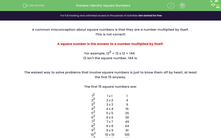A common misconception about square numbers is that they are a number multiplied by itself.
This is not correct!
A square number is the answer to a number multiplied by itself.
For example, 122 = 12 x 12 = 144
12 isn't the square number, 144 is.
The easiest way to solve problems that involve square numbers is just to know them off by heart, at least the first 15 anyway.
The first 15 square numbers are:
| 12 | 1 x 1 | 1 |
| 22 | 2 x 2 | 4 |
| 32 | 3 x 3 | 9 |
| 42 | 4 x 4 | 16 |
| 52 | 5 x 5 | 25 |
| 62 | 6 x 6 | 36 |
| 72 | 7 x 7 | 49 |
| 82 | 8 x 8 | 64 |
| 92 | 9 x 9 | 81 |
| 102 | 10 x 10 | 100 |
| 112 | 11 x 11 | 121 |
| 122 | 12 x 12 | 144 |
| 132 | 13 x 13 | 169 |
| 142 | 14 x 14 | 196 |
| 152 | 15 x 15 | 225 |
Let's practise using these numbers in calculations now.
Squaring an integer:
e.g. Find the value of 62
6 x 6 = 36
Squaring a decimal:
One thing examiners like to do is to tie in one topic with another.
If you ever see a question involving squaring a decimal without a calculator, it will be based around the square numbers which you would already have knowledge of.
e.g. Find the value of 1.22
This just means we need to find the value of: 1.2 x 1.2
If we look at our table, we can see that:
12 x 12 = 144
So 1.2 x 1.2 = 1.44 when we put our decimal point back in.
Great focus!
In this activity, you will find square numbers and apply your knowledge of square numbers to solve problems.
Now let's attack some questions and really consolidate our knowledge.








